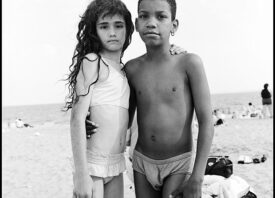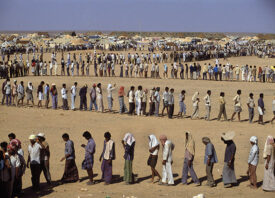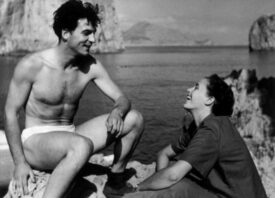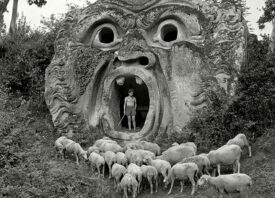Search this site
60 Magnum Photographers Reveal Their Most ‘Decisive Moment’

“I spent more than a year working in Tripoli’s Bab al-Tabbaneh district in Lebanon, documenting a politically fueled sectarian conflict. I visited many homes on the frontline but people rarely wanted to be photographed because they were afraid, so I often returned home without having even turned my camera on.
“The day I took this photo, I climbed the stairs to the top floor of a building, which was riddled with bullet holes. When I was leaving one apartment, I turned and saw the children there on the chairs in front of the shattered wall; they seemed to perfectly sum up how families were living in the middle of the conflict. With one foot already outside the door, I raised my camera and snapped. Lebanon. Tripoli. November 2013 © Lorenzo Meloni / Magnum Photos
“To take a photograph is to align the head, the eye and the heart,” Henri Cartier-Bresson famously proclaimed. Five years after co-founding Magnum Photos, he published what is perhaps the most iconic book in photographic history. With that now familiar cover by contemporary Henri Matisse, The Decisive Moment, as it was called in English, defined the parameters of what it meant to be a photographer in the 20th century. Everything–the head, the eye, the heart, but also the frame, the light, the shapes–had to come together in one precarious, frozen fragment in time. The book’s title in French, Images à la Sauvette, or “images on the run” provides insight into the vigilance with which Cartier-Bresson saw the world around him. To blink was to miss the photograph you sought.
In 2017, Magnum Photos will celebrate the 70th anniversary of its founding, or as press contact for the cooperative more appropriately called it, “their birthday.” With Magnum, Cartier-Bresson delivered a new photographic era, and sadly, he and his three fellow founders–Robert Capa, David Seymour, and George Rodger– have all passed away, leaving behind their pictures.
Magnum has seen the generations come and go, but what of it’s founder’s “decisive moment?” There has been rebellion against the seemingly imposed sense of order held dear by Cartier-Bresson and his contemporaries. Some have gone so far as to dub the very idea “old fashioned,” best suited to the 1950s.
Still, even by challenging the decisive moment, we paradoxically concede to it. The choice to abandon the decisive moment is itself decisive. Perhaps Cartier-Bresson even anticipated the changing of the tides decades ago when he amended the personal copy of the book belonging to Martin Parr, changing it to read instead ‘The More or Less Decisive Moment(s).’
In honor of their upcoming birthday, Magnum is hosting one of its revolutionary square print sales. Signed prints by dozens of their finest photographers will be made available to the public. This time around, the participating photographers, relatives, or estates were asked to select an image that defines what ‘The More or Less Decisive Moment(s)’ means to them. Twelve of the stories are included here, and the rest can be seen, and purchased, at the Magnum Print Store.
As per usual, the prints are limited not by number but by time. The window to purchase prints for an extraordinary $100 starts right now and ends promptly at 11 PM on June 10th.

“Sometimes, you realize that you’re part of a moment that has all the visual elements that are necessary to create a good photo, and therefore communicates the atmosphere you were a part of. For me, that is the decisive moment. I had such a moment with this family in Amarillo, Texas. They had every reason to be unhappy and give up: three of the four family members were sick, they were poor and lived in a very dirty small trailer full of pests. Instead of going home, the parents often picked their children up after school and drove around town. That particular day in the cold winter they went to buy sodas and chips and decided, instead of going to the movies, to drive around the rich neighborhoods to watch the overwhelming Christmas lights covering these big houses.
“They never felt any jealousy towards the rich, they were just enjoying the beautiful lights and their time together. I felt the same and was happy that they shared this moment with me. This kind of moment is very rare and only happens to me about once or twice a year.” © Bieke Depoorter / Magnum Photos

“This image recalls a moment in my own life; it puts me in the shoes of myself before I moved abroad in my thirties, just starting my career as a photographer, so is this how I saw the US back then? Having returned to make new images after almost a decade away, it begs me to consider how I’ve changed, how my perceptions of this country have changed, and how image-making has changed. This is one of the few early images of mine that have stayed with me over time.” USA. Wellington, Florida. 2005 © Carolyn Drake / Magnum Photos

“Unfortunately, I can’t tell you any more than what you see in the photo. I, myself, didn’t see anything; I walked by without slowing my pace. My shadow with my lowered head is also captured in this moment—witnessing that I wasn’t a witness. Although this was one of my first forays into street photography, my reflexes didn’t fail me.
“By this point I had attained certain mastery in another area of photography: ‘fine art’ photography. My work even managed to garner some praise from Tarkovsky, but at the same time he, too, advised me to go shoot the street. I remember his words: ‘For me, photography is Cartier-Bresson.’ ‘Why?’ I asked; the name meant nothing to me.
“And then he pronounced the formula of this ‘Great Differential’—the value of a moment in space and time.
Eventually, I became convinced that the decisive moment isn’t about the skill of choosing a moment and designating it the decisive one, but something else entirely. Here, the moment decides, not you. Your role is rather to trust it and not get in the way; to stop controlling it, and then it will present you with what Cartier-Bresson called ‘objective chance,’ ‘El momento de la verdad.’” Moscow, Russia, Soviet Union. 1981. An attempted murder. The aggressor plunges a shank into his victim’s stomach. © Gueorgui Pinkhassov / Magnum Photos

“I took this image at the Black Sea beachfront in the city of Sukhumi in the unrecognized republic of Abkhazia. Tourists and locals were hanging out picnicking and bathing. When people are hurling themselves from old shipwrecks I don’t necessarily think, ‘Oh, here is a decisive moment’. Actually, I often don’t think so much at all when I photograph, it is more gut instinct working, just lots of reactions. For me, the thinking and categorizing is better done before and after the actual photographing. Anyways, I don’t think too much about the classic concept of the decisive moment, for me, they are just moments. Some are complicated, where lots of elements come together; some are simple low-hanging fruit; some are long, drawn-out sluggish affairs; others are over in a split second. Whatever it is, the shutter had better be open at the right time.” Georgia. Abkhazia. Sukhum. 2005 © Jonas Bendiksen / Magnum Photos

“I took this photograph in 1994 in a small desert Mennonite colony in the center of Mexico. I’d met members of the Old Colony sect five years earlier as they’d arrived in Canada hungry, dirt-poor migrant workers. I often accompanied them back home to Mexico. The community of 850 souls had welcomed me as a friend from the north over the course of several years.
I’d just visited Jacob and Sarah Dyck in their adobe house that looked like a chicken coop, yet it was clean and orderly inside and smelled of laundry soap. A newborn baby yawned in a homemade cradle; the neighbor girl looked down as I exited, shy— children seldom saw outsiders. The shadow of a windmill squeaked and then slowly struggled to lift water to the surface during another year of unmitigated drought. I took a picture. She sprang and ran home. I still wonder if my modern and worldly obsession had frightened her.” Mexico. La Batea. Zacatecas. 1994. © Larry Towell / Magnum Photos

“For my project Listen I made a series of imaginary CD covers for six women singers. I shot several situations, but this one, taken on the shores of the Caspian Sea, came about by a stroke of luck. My sister (the model) was waiting in the freezing water, waves were breaking all around her, there was wind and there were onlookers. I hurriedly made a series of shots, focusing on her while she was withstanding the elements. I remember driving home wondering if I had gotten the picture I wanted. I shot analogue so had no way of knowing. When I got the contact sheets it became clear that for one image everything that I was looking for had fallen into place: two waves are breaking at exactly the right moment, her position is just as I hoped it to be. Most importantly, her gaze, straight into the lens, for me at least, completes the picture.” Iran. Mahmoudabad. Caspian Sea. 2011 © Newsha Tavakolian / Magnum Photos

“I shot this image in 1988 when I was doing my second book on Delhi. While driving past, I saw the main door of a wresting complex (Akhara) garishly painted with two guys in a dramatic wresting posture. I stopped and as I pushed the door open this is what was going on inside. I stayed on the spot and shot a few frames where the inside and outside human body shapes came into certain relationships, thanked them, shut the door and came back.
“There are certain situations that are physically very dramatic and potent; what you need to do is to wait for the moment when respective elements–in this case human forms and physical action–come into a certain kind of rhythm and relationship to make the experience whole and enhance the strength and structure of the frame, bringing a certain kind of dynamism into it. Of course, the colors were dramatic and the forms did the rest of it, and this is how the decisive moment appears to disappear again.” India. Delhi. © Raghu Rai / Magnum Photos

“Chim (David Seymour, 1911-1956) captured this instantly recognizable, proud and decisive moment as a smiling father shows off his baby daughter. The joyous feelings for this first newborn in the settlement of Alma (established by a group of Italian converts to Judaism) in 1951 must have been especially strong in young Israel. Israel was itself a newborn nation, still recovering from the trauma of World War II and the tragedy of the Holocaust. The white dress for daughter Miriam echoes the whitewashed new buildings behind her and the billowing clouds above her. Ironically, this sort of white gown is typically worn by baby boys for their circumcision but it was put to good use for this celebration. Viewers of this photo can easily assume that Chim was equally proud of the youthful spirit of Israel, which reverberates from this photo. Chim wrote to his sister: ‘You can imagine how everything here is emotionally charged and moving.'” Israel. 1951 © David Seymour / Magnum Photos

“This photo has become well known, which is, in a way, quite understandable, but for the people of Burma or Myanmar, especially Buddhists, the way I composed this without a holy pagoda on the top of the rock is disturbing. I went to the rock three times, and I visited the wonderful land and people, so opposite of America, well over 50 times between 1975 and 78. It has a lot to do with my coverage on the fall of Saigon for a popular American weekly magazine for six weeks in 1975. I was desperate to keep a distance from America for a while; luckily, I found Burma and its gentle and compassionate people. In the spring of 1978, on the top of the hill where I took this photo, I had two Leica bodies: the one with Tri-X and the other with Kodachrome 64. Soon after, I realized that the color one looked very colorful and was more powerful. That was my decisive moment, to become a color photographer.” Burma. Kyaiktiyo. 1978. © Hiroji Kubota / Magnum Photos

“A good photograph should not need a description; it should speak for itself, and I cannot possibly know why Erich took this picture nor what he was thinking at the time on that snowy day in Midtown, New York.
“I am, however, able to tell you something about his working habits. He saw pictures everywhere and was never without a camera, indoors or out, in all seasons and all circumstances. No matter what other heavy or cumbersome photographic gear he might have been carrying, he always had easily accessible, a small loaded camera and some extra film.
“Perhaps this picture should be described not as a ‘decisive moment’, but as a ‘unique moment’ because of the many components coming together at the same instant. It is unlikely that ever again on a winter’s day in New York would that same young woman be sitting in a bus near enough to where Erich was standing for him to take a picture of her that also included within the frame a well-spaced group of passengers outside struggling against the storm, some entering the bus from the snow-filled street, others leaving to face the wind and the cold.” — Ruth Bains Hartmann, widow of Erich Hartmann. USA. New York City. 1967. © Erich Hartmann / Magnum Photos

“Sometimes I’m able to capture a decisive moment and other times, call it slow or lazy, I’m just dumbfounded by what is in front of me and am either late or I completely forget about photography and take no picture. In this case, I was lucky the dumbfoundedness allowed me to at least be late and to take a ‘more or less’ decisive moment. It is ‘more or less’ decisive because when I consider the decisive moment I of course think of Henri Cartier-Bresson and a photograph with a subject engaged in a moment that lasts a fraction of a second. In this image there is a moment with the street barber and his tools, but it is secondary to the boy’s expression, the subject, which continued for at least a minute. From the time I first spotted him amid a flurry of shoppers during rush hour in downtown Dalian, China, until after the photograph was taken he was still as a stone, just like this.” China. Dalian. 2010 © Michael Christopher Brown / Magnum Photos
Signed or estate stamped prints for $100 from over 60 Magnum photographers and artists will be available for a limited time, from 9am EST on Monday 6 June until 11pm Friday 10 June 2016, here.



